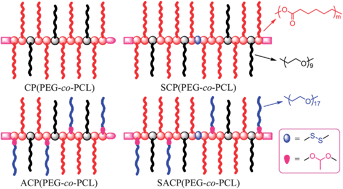a Jiangsu Key Laboratory of Advanced Functional Polymer Design and Application, Department of Polymer Science and Engineering, College of Chemistry, Chemical Engineering and Materials Science, Soochow University, Suzhou 215123, China
b School of Materials Science and Engineering, Key Laboratory of Advanced Civil Engineering Materials of Ministry of Education, Tongji University, 4800 Caoan Road, Shanghai 201804, China
Polym. Chem. 2013, 4, 3398-3410.
Disulfide- and acetal-functionalized comb-like copolymers (SACP) with poly(ε-caprolactone) (PCL) and poly(ethylene glycol) (PEG) side chains and a polymethacrylate backbone were synthesized and self-assembled for in vitro encapsulation and release of an anticancer drug, doxorubicin (DOX). Three step reactions including RAFT copolymerization of 2-hydroxyethyl methacrylate and poly(ethylene glycol) methyl ether methacrylate mediated by a disulfide-functionalized RAFT agent, hydroxyl-vinyloxy addition reaction to introduce acid cleavable PEG segments, and CL polymerization to grow PCL chains were used to generate the target dual-sensitive comb-like copolymers. Meanwhile, well-defined normal comb-like polymers (CP), acid-cleavable comb-like polymers (ACP) and disulfide-linked comb-like polymers (SCP) with PEG and PCL pendent chains were also prepared and acted as analogues of SACP. All the resultant comb-like copolymers had the desired chemical structures, well-controlled molecular weight and relatively low polydispersity (PDI = 1.09–1.16), evident from 1H NMR and GPC-MALLS analyses. DLS and TEM measurements revealed that these copolymers were liable to self-assemble into micelles or large compound micelles in aqueous solution, and SACP aggregates could be dissociated and reaggregated in the presence of acidic PBS solution (pH 5.0) or 10 mM DL-dithiothreitol (DTT). Compared with CP aggregates with a lack of cleavable linkage, ACP, SCP and SACP aggregates upon acid and reduction stimuli could quickly release the encapsulated DOX, and the cumulative release from SACP aggregates could be roughly adjusted by addition of a single stimulus or dual stimuli. These results confirmed their great potential as novel nanocarriers and delivery systems.

链接: //pubs.rsc.org/en/content/articlelanding/2013/py/c3py00252g#!divAbstract